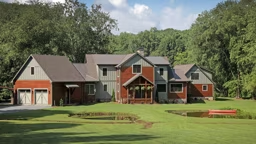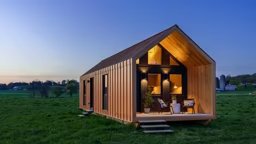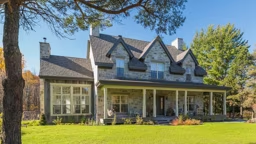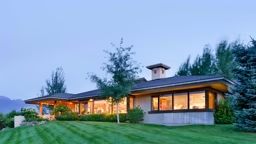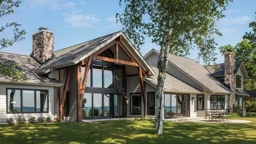There's a stretch of Idaho’s Henrys Fork River called “The Harriman Ranch” that attracts fly-fishermen – well, like flies. It’s considered by many fly-anglers to be the holiest water in a part of the country that’s famous for its holy waters. Phil and Kate Barker, accomplished anglers, first came to the land of the Yellowstone cutthroat trout as newlyweds.
“We camped and fished at the storied Ranch and enjoyed it so much we ended up buying a piece of property there,” recalls Phil. “But we knew we’d have to work a good long time before we’d have the resources to build.” Still, that didn’t prevent the enterprising software engineer and his wife, who now reside near San Francisco, from fishing. They returned to the region pretty much every year, and dreamed of building a place there.
Then one summer, a stop at Madison River Outfitters in West Yellowstone, Mont., provided the inspiration they needed to push their dreams toward reality. “The structure [of the shop was constructed out of these beautiful massive logs,” says Phil. After inquiring about the builder, he received an introduction to Blair Anderson of Hilgard Log Builders. “I asked Blair if he’d be willing to work with us when we were ready. It took a few years, but in 2002 we started building.” Phil’s desire for a cabin getaway was likely fueled by summers he spent at his grandfather’s cabin north of Toronto. “It was just beautiful and was on its own island,” he says. “He built it himself, hauling the logs across the ice in the winter.”
Hands-On Experience
And while he never envisioned wielding a chain saw, Phil was determined to be as hands-on as possible when the time came.
During that interim period, he initiated many conversations with Anderson regarding best log-building practices. “Over the years I got quite an education,” says Phil. He rapidly learned about everything from paying attention to the length of readily available logs and not designing something that needs 60 footers, to placing the fireplace and chimney within the structure to avoid slip joints between stone and logs.
For his part, Anderson encouraged his eager pupil. “The best projects are when the owners are significantly involved, and Phil and Kate were totally into it every step of the way,” he says. When he felt he had adequate information, Phil called on his love of mechanical drawing and background in fine arts to draft plans. “I went through a few iterations to get the sizing and scale right, and when we took the drawing to an engineer, structurally we didn’t need to change a thing,” he says.
Siting the Cabin
Meanwhile, Anderson worked with his clients to develop a plan that suited the 20-acre property, located in a cabin subdivision. They took into consideration the prescribed building envelope determined by the subdivision to prevent people from obstructing each other’s vistas. “We preserved the views of Henrys Lake to the south as well as protected the house from the prevailing winds,” says Anderson, who placed the kitchen, dining room and master bedroom on the east side where the rooms would enjoy morning sun.
Design – Best Practices
Everyone was in agreement about keeping the cabin size and cost down. “We wanted a very simple design that was comfortable for Kate and me and our two children who were teenagers at the time,” says Phil, who also applied his drafting skills to the interior design.
“In order to optimize the usage of space, I created a floor plan for each room by using a blueprint-size drawing of each floor with to-scale furniture cutouts. From there, we were able to orient the furniture and confirm adequate space.”
And because no cabin is complete without a fireplace, the cabin owner once again entered into a pursuit of best practices, but this time about stone. “We found Phil Cox (a local stonemason) through a book, and he came over and literally sketched the Rumford-style fireplace in front of us,” he says about the two-story raised hearth design. “We needed to expand the size of the room to fit the 60,000 pounds of dry-stacked fieldstone.” Editor’s Note: The book referenced was “Rustic Fireplaces” by Ralph Kylloe (Gibbs Smith, May 2007).
Fun With Furnishings
Like all Hilgard structures, the Barkers’ western red cedar cabin arrived on a flatbed truck with each log numbered and ready for assembly. Once the cabin was erected, the ecstatic homeowners wasted no time filling the rooms with the collection of antique furnishings and accessories they began acquiring long before they broke ground. “Kate and I have always loved antiques, and we wanted the majority of the furnishings to be old, including the light fixtures, door handles and cabinet knobs,” says Phil. He and Kate spent many months scouring flea markets, antique shows and eBay for the perfect items.
Outdoor Play
Their getaway complete, the Barkers were ready to reap the benefits of life on Henrys Lake and wasted no time wetting their lines.
While they do occasionally partake in other activities – Kate is an active member of Women of the Wild, a local hiking group – they are mainly there to fish, like everyone else who comes to the area.
“Everyone tries to catch the very big wild rainbows, and when you get one over 25 inches, that’s a real trophy,” says Phil, noting he’s never caught one but boasts that his wife did. “Kate became an instant local celebrity, and they gave her a pin that’s properly affixed to her fishing vest. I keep hoping she might let me wear it sometime.”
The kids – who are now grown and join their parents every summer – are good anglers too, but they break up the fishing with horseback riding. On their occasional winter visits, everyone enjoys snowmobiling and taking ATV rides to Sawtelle Peak, which offers commanding views of Yellowstone National Park and the Teton Range.
Now fully retired, the Barkers have discovered retirement has its benefits, including extending the time they spend at their lakeside retreat, which has translated into more hours to kick back and entertain. “All of our friends at the lake are also retired, so get-togethers for dinner are pretty frequent,” says Phil, noting that the layout of the kitchen, breakfast bar, dining table and living room makes serving a buffet-style meal a breeze. “It’s all very easygoing with no real defined schedule – except for when the fish are biting.”
Design & Decor
Call it serendipity, but the very first thing Phil and Kate Barker purchased for their Henrys Lake fly-fishing cabin was a myrtle wood coffee table with a glass top that encased 400 museum-quality fishing flies. “We were making our way to San Francisco and only had $500 to our names, but we just had to have it,” says Phil who paid $125 for the item at a street fair in Danville, Calif. “Kate’s dad took it apart and turned it into a frame, and it hangs in the entry to our cabin.”
Bargain Hunting
That table was the first of many items the Barkers would purchase at street fairs, in antique stores and from the Internet as they sought chairs, dressers, lighting and accessories for their getaway. Bargain hunting was part of the fun, but they also wanted there to be some cohesion to the interior design. “I’ve always loved the American Victorian, so dressers and nightstands with marble tops were in, as were glass door knobs,” says Phil who along with his wife hunted for items that worked well together and made sense in the casual setting. “We stumbled on deal after deal,” he says.
The couple happended upon a $400 wagon wheel light fixture from an antique store in Pleasanton, Calif., found a Belgian oak dining room table and six rush chairs that cost $600 at a street fair in Fremont, Calif., and unearthed a $900 kitchen hutch at an antique fair in San Mateo, Calif. “The hutch has the original rolled glass and is probably worth closer to $10,000,” adds Phil.
Color Scheme
When it came to color scheme, they let the textures and tones of the western red cedar logs lead the way. “We really didn’t see putting up drywall or using paint,” Phil says. “We wanted the natural grandeur of the wood and that reddish tone to shine through.” The red thread starts in the living room where the shades on the wagon wheel chandelier sport the bold hue, continues in the kitchen where the cabinets are painted poppy, peeks out from the floral curtains and bedspread in the master bedroom, and brightens the linens in the guest room.
Ready to Entertain
Their few new purchases included high quality leather sofas for the living room, selected for comfort as well as utility. “Entertaining is a big part of our lives, so adequate seating was important,” says Phil, noting that the sofas seat seven, the hearth can accommodate three and the overall layout is conducive to big gatherings. “Our largest party was for 35 people, and everyone had a seat.”
Home Details
Completed: 2006
Location: Henrys Lake, Idaho
Square Feet: Main cabin is 2,400;log garage is 800
Bedrooms: 2 (plus 2 sleeping berths in loft)
Baths: 2
Design Resource: Hilgard Log Builders














